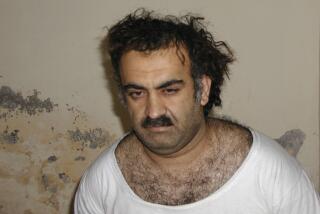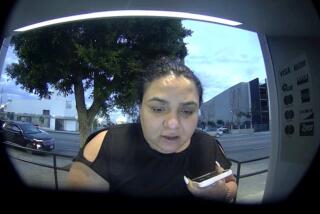A Piece of the Terrorism Puzzle Seen in Court
WASHINGTON — A middle-aged man from Syria stood up in a federal courthouse in Virginia on Thursday and admitted that, for some time, he had been operating an unlicensed money service business in this country.
Louay Habbal, a 45-year-old naturalized U.S. citizen, pleaded guilty to transferring millions of dollars to individuals overseas.
Though there was no definite link between any of the money and terrorists, federal authorities said that was how Al Qaeda and other terrorist networks operated in the United States and abroad.
“Any criminal or terrorist can have their millions wired anywhere in the world in a matter of seconds with no questions asked,” said Allan Doody, a federal law enforcement supervisor in Washington.
That scene, coming against the backdrop of death and destruction in London’s mass transit system, is an example of an intense federal effort to prosecute anyone who appears to have terrorist ties -- an approach that has been criticized as sometimes being overly ambitious. But those involved in the effort said it highlighted how much work remained to defuse the terrorist threat.
Since the Sept. 11 attacks on New York and the Pentagon, five large groups reputed to be terrorist cells had been broken up, from Lake Erie to Puget Sound. Criminal charges have been brought against 401 people in the United States in terrorism-related investigations. Of those, 212 have been convicted or have pleaded guilty. Another 415 people have been removed from the U.S. because of Sept. 11 investigations.
Despite those numbers, many in law enforcement contend the U.S. remains as vulnerable as London commuters found themselves to be Thursday morning.
“My personal opinion is that if we are going to continue to live in an open society, then it’s next to impossible to prevent this type of terror attack,” said Bill Gore, former head of the FBI field office in San Diego, where several of the Sept. 11 hijackers had lived.
Gore and other law enforcement experts said that short of searching every train passenger carrying a backpack, stationing around-the-clock police guards at all of the nation’s dams, or repeatedly testing the nation’s food and medical supplies, terrorists would find a loophole to exploit.
They said the risk could be lowered but not eliminated.
Lee Strickland, a former CIA senior intelligence analyst and now a professor of information policy at the University of Maryland, said that law enforcement had worked hard since Sept. 11 to upgrade security at the nation’s airports. But, he said, they did that knowing that other sites -- such as schools, hospitals and surface transportation systems -- remained vulnerable.
“We need to continue to look at innovative approaches to address these other risks,” Strickland said.
“Rather than just having ‘mindless security,’ we have to be really smart. We have to have really good intelligence. Because there’s a lot of infrastructure out there.”
Justice Department officials said Thursday that they were continuing to gather and cultivate detailed knowledge about potential future attacks.
Hundreds of suspected terrorists, they said, have been identified and tracked throughout the United States in recent years.
To combat these concerns, these officials said, they have increased by 30% the number of sources, or “human assets,” providing intelligence on possible domestic terrorist activity since Sept. 11. In addition, counter-terrorism investigations have doubled since the World Trade Center towers fell.
Critics have accused authorities of exaggerating their successes, noting that many arrested as terrorism suspects were charged with immigration violations and other minor offenses. But authorities contend that has been, in part, a strategy they call “leveraging” -- they file stiff criminal charges against terrorism suspects to try to get them to plead guilty to lesser offenses and cooperate with authorities in identifying other terrorist plots.
Prosecutors said the ploy had been working. They said they had obtained invaluable information about safe houses, training camps and Al Qaeda recruitment tactics in the U.S. One suspect gave them critical information about weapons stored here. Another identified U.S. sites that were being scouted for attacks.
Authorities praise provisions in the Patriot Act that have given them enhanced tools to fight terrorists. An example is the arrest of Rajib Mitra, who in 2003 jammed the police emergency radio system in Madison, Wis., 21 times. He was convicted in May 2004 and sentenced to eight years in prison on a new federal charge under the Patriot Act designed to protect emergency computers.
Other cases remain open, notably the anthrax attacks on the East Coast that followed the Sept. 11 attacks. It immediately put law enforcement officials on notice that hijacked airplanes were not the only weapons of choice for terrorists.
One U.S. intelligence official, who spoke on condition of anonymity because he worked closely with counter-terrorism units from other countries, said that London authorities had one of the world’s best anti-terrorist police forces. He said they had trained for years because of London’s experience with attacks by the Irish Republican Army. Yet the terrorists got past them Thursday.
“Al Qaeda has a big umbrella and a big blanket that covers a lot of things,” the intelligence official said. “And in a free society this kind of thing can happen anywhere.”
Authorities decided to take no chances with Louay Habbal. In federal court in Alexandria, Va., he admitted receiving about $6 million from customers in the U.S. and depositing that money in various bank accounts. After taking a portion of the money for himself, Habbal wired the rest to individuals overseas.
Paul McNulty, the U.S. attorney in Alexandria, said that although there was no direct link between Habbal and terrorists, federal authorities would aggressively prosecute those who even remotely -- or perhaps unknowingly -- helped terrorists to “facilitate their crimes.”
More to Read
Sign up for Essential California
The most important California stories and recommendations in your inbox every morning.
You may occasionally receive promotional content from the Los Angeles Times.











